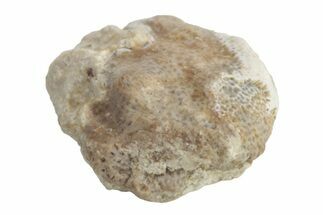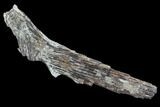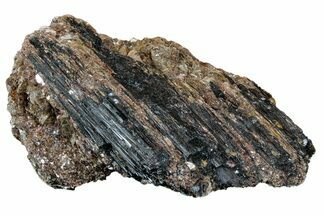This Specimen has been sold.
9.2" Ichthyodectes Caudal Fin & Associated Vertebrae - Kansas
This is a 9.2" long caudal fin (tail fin) bones and vertebrae association from Ichthyodectes (meaning fish biter with comb teeth), closely related to Xiphactinus audax and the 2-meter long Gillicus arcuatus. Large ichthyodectes grew to more than 10 feet long and lived in the U.S. Western Interior Seaway during the late Cretaceous Period. This natural bone association was collected from the Smoky Hill Chalk in Gove County, Kansas. There are 4 vertebra that remained intact and associated with the caudal fin.
It comes with an acrylic display stand.
The Smoky Hill Chalk Member of the Niobrara Chalk formation is a Cretaceous conservation Lagerstätte, or fossil rich geological formation, known primarily for its exceptionally well-preserved marine reptiles. It outcrops in parts of northwest Kansas, its most famous localities for fossils, and in southeastern Nebraska. Large well-known fossils excavated from the Smoky Hill Chalk include marine reptiles such as plesiosaurs, large bony fish such as Xiphactinus, mosasaurs, flying reptiles or pterosaurs (namely Pteranodon), flightless marine birds such as Hesperornis, and turtles. Many of the most well-known specimens of the marine reptiles were collected by dinosaur hunter Charles H. Sternberg and his son George.
It comes with an acrylic display stand.
The Smoky Hill Chalk Member of the Niobrara Chalk formation is a Cretaceous conservation Lagerstätte, or fossil rich geological formation, known primarily for its exceptionally well-preserved marine reptiles. It outcrops in parts of northwest Kansas, its most famous localities for fossils, and in southeastern Nebraska. Large well-known fossils excavated from the Smoky Hill Chalk include marine reptiles such as plesiosaurs, large bony fish such as Xiphactinus, mosasaurs, flying reptiles or pterosaurs (namely Pteranodon), flightless marine birds such as Hesperornis, and turtles. Many of the most well-known specimens of the marine reptiles were collected by dinosaur hunter Charles H. Sternberg and his son George.
SPECIES
Ichthyodectes
LOCATION
Gove County, Kansas
FORMATION
Niobrara Formation
SIZE
9.2" long (straightline)
CATEGORY
SUB CATEGORY
ITEM
#93768
We guarantee the authenticity of all of our specimens.
 Reviews
Reviews














